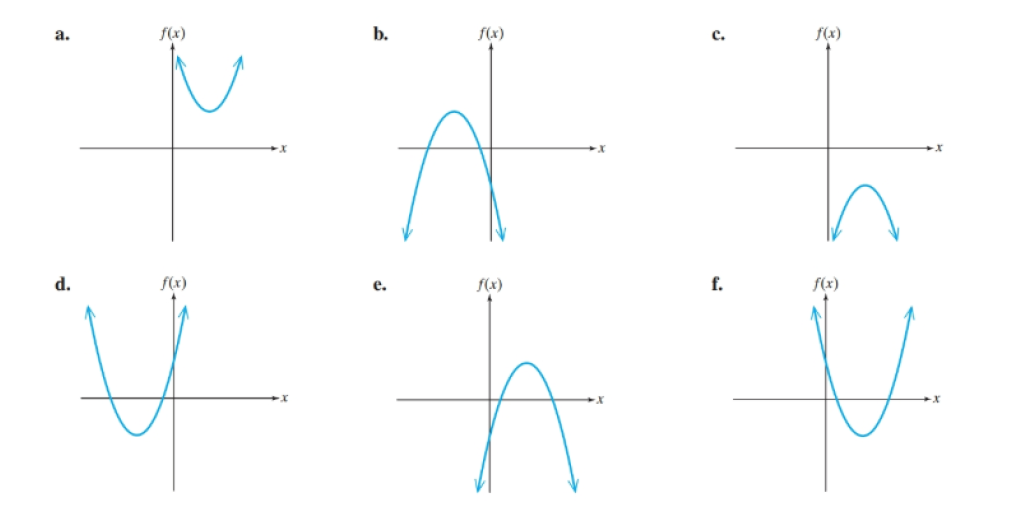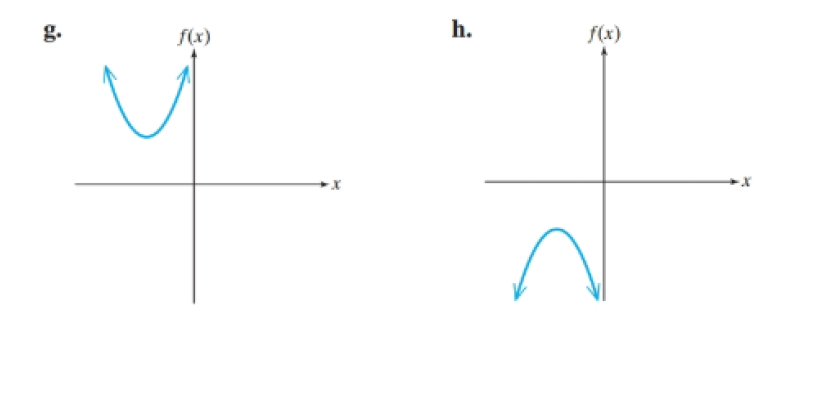Problem 1SP: Skill Practice 1
Repeat Example 1 with
Problem 2SP: Skill Practice 2 Repeat Example 2 with f(x)=3x26x+1 Problem 3SP: Skill Practice 3 Repeat Example 3 with f(x)=x24x7. Problem 4SP: Skill Practice 4 A quarterback throws a football with an initial velocity of 72 ft/sec at an angle... Problem 5SP: Skill Practice 5
A farmer has 200 ft of fencing and wants to build three adjacent rectangular... Problem 6SP: Skill Practice 6 The funding f(t) (in $ millions) for a drug rehabilitation center is given in the... Problem 1PE: 1. A function defined by is called a _______ function.
Problem 2PE Problem 3PE Problem 4PE Problem 5PE: 5. Given if, the parabola opens (upward/downward) and the (minimum/maximum) value is __________.
Problem 6PE Problem 7PE: For Exercises 7–14,
a. Determine whether the graph of the parabola opens upward or downward.
b.... Problem 8PE: For Exercises 714, a. Determine whether the graph of the parabola opens upward or downward. b.... Problem 9PE: For Exercises 7–14,
a. Determine whether the graph of the parabola opens upward or downward.
b.... Problem 10PE: For Exercises 7–14,
a. Determine whether the graph of the parabola opens upward or downward.
b.... Problem 11PE: For Exercises 714, a. Determine whether the graph of the parabola opens upward or downward. b.... Problem 12PE: For Exercises 714, a. Determine whether the graph of the parabola opens upward or downward. b.... Problem 13PE: For Exercises 714, a. Determine whether the graph of the parabola opens upward or downward. b.... Problem 14PE Problem 15PE: For Exercises 15–24,
a. Write the function in vertex form.
b. Identify the vertex.
c. Determine the... Problem 16PE Problem 17PE: For Exercises 15–24,
a. Write the function in vertex form.
b. Identify the vertex.
c. Determine the... Problem 18PE: For Exercises 1524, a. Write the function in vertex form. b. Identify the vertex. c. Determine the x... Problem 19PE: For Exercises 1524, a. Write the function in vertex form. b. Identify the vertex. c. Determine the x... Problem 20PE: For Exercises 15–24,
a. Write the function in vertex form.
b. Identify the vertex.
c. Determine the... Problem 21PE: For Exercises 1524, a. Write the function in vertex form. b. Identify the vertex. c. Determine the x... Problem 22PE Problem 23PE: For Exercises 1524, a. Write the function in vertex form. b. Identify the vertex. c. Determine the x... Problem 24PE Problem 25PE: For Exercises 2532, find the vertex of the parabola by applying the vertex formula. f(x)=3x242x91 Problem 26PE Problem 27PE: For Exercises 2532, find the vertex of the parabola by applying the vertex formula. k(a)=13a2+6a+1 Problem 28PE: For Exercises 2532, find the vertex of the parabola by applying the vertex formula. j(t)=14t2+10t5 Problem 29PE: For Exercises 25–32, find the vertex of the parabola by applying the vertex formula.
29.
Problem 30PE: For Exercises 25–32, find the vertex of the parabola by applying the vertex formula.
30.
Problem 31PE: For Exercises 25–32, find the vertex of the parabola by applying the vertex formula.
31.
(Write... Problem 32PE: For Exercises 2532, find the vertex of the parabola by applying the vertex formula.... Problem 33PE: For Exercises 33–42,
a. State whether the graph of the parabola opens upward or downward.
b.... Problem 34PE: For Exercises 33–42,
a. State whether the graph of the parabola opens upward or downward.
b.... Problem 35PE: For Exercises 33–42,
a. State whether the graph of the parabola opens upward or downward.
b.... Problem 36PE: For Exercises 3342, a. State whether the graph of the parabola opens upward or downward. b. Identify... Problem 37PE: For Exercises 3342, a. State whether the graph of the parabola opens upward or downward. b. Identify... Problem 38PE: For Exercises 33–42,
a. State whether the graph of the parabola opens upward or downward.
b.... Problem 39PE: For Exercises 33–42,
a. State whether the graph of the parabola opens upward or downward.
b.... Problem 40PE: For Exercises 3342, a. State whether the graph of the parabola opens upward or downward. b. Identify... Problem 41PE: For Exercises 3342, a. State whether the graph of the parabola opens upward or downward. b. Identify... Problem 42PE: For Exercises 3342, a. State whether the graph of the parabola opens upward or downward. b. Identify... Problem 43PE: 43. The monthly profit for a small company that makes long-sleeve T-shirts depends on the price per... Problem 44PE: 44. The monthly profit for a company that makes decorative picture frames depends on the price per... Problem 45PE: A long jumper leaves the ground at an angle of 208 above the horizontal, at a speed of 11 m/sec. The... Problem 46PE: 46. A firefighter holds a hose 3 m off the ground and directs a stream of water toward a burning... Problem 47PE: 47. The population of a culture of the bacterium Pseudomonas aeruginosa is given by, where t is the... Problem 48PE: 48. The gas mileage m(x) (in mpg) for a certain vehicle can be approximated by, where x is the speed... Problem 49PE: 49. The sum of two positive numbers is 24. What two numbers will maximize the product? (See Example... Problem 50PE Problem 51PE Problem 52PE Problem 53PE: Suppose that a family wants to fence in an area of their yard for a vegetable garden to keep out... Problem 54PE: 54. Two chicken coops are to be built adjacent to one another using 120 ft of fencing.
a. What... Problem 55PE: 55. A trough at the end of a gutter spout is meant to direct water away from a house. The homeowner... Problem 56PE: A rectangular frame of uniform depth for a shadow box is to be made from a 36-in. piece of wood. a.... Problem 57PE Problem 58PE: Gas mileage is tested for a car under different driving conditions. At lower speeds, the car is... Problem 59PE: 59. Fluid runs through a drainage pipe with a 10-cm radius and a length of 30 m (3000 cm). The... Problem 60PE: The braking distance required for a car to stop depends on numerous variables such as the speed of... Problem 61PE Problem 62PE: For Exercises 6164, given a quadratic function defined by f(x)=ax2+bx+c(a0), answer true or false.... Problem 63PE Problem 64PE: For Exercises 61–64, given a quadratic function defined by, answer true or false. If an answer is... Problem 65PE Problem 66PE Problem 67PE Problem 68PE Problem 69PE Problem 70PE Problem 71PE Problem 72PE: For Exercises 71–78, given a quadratic function defined by, match the graph with the function based... Problem 73PE Problem 74PE: For Exercises 7178, given a quadratic function defined by f(x)=a(xh)2+k(a0), match the graph with... Problem 75PE Problem 76PE Problem 77PE: For Exercises 71–78, given a quadratic function defined by, match the graph with the function based... Problem 78PE: For Exercises 7178, given a quadratic function defined by f(x)=a(xh)2+k(a0), match the graph with... Problem 79PE Problem 80PE Problem 81PE Problem 82PE Problem 83PE Problem 84PE Problem 85PE Problem 86PE Problem 87PE Problem 88PE: For Exercises 85 88, define a quadratic function y=f(x) that satisfies the given conditions. Axis of... Problem 89PE Problem 90PE Problem 91PE Problem 92PE format_list_bulleted




 Algebra and Trigonometry (MindTap Course List)AlgebraISBN:9781305071742Author:James Stewart, Lothar Redlin, Saleem WatsonPublisher:Cengage Learning
Algebra and Trigonometry (MindTap Course List)AlgebraISBN:9781305071742Author:James Stewart, Lothar Redlin, Saleem WatsonPublisher:Cengage Learning College AlgebraAlgebraISBN:9781305115545Author:James Stewart, Lothar Redlin, Saleem WatsonPublisher:Cengage Learning
College AlgebraAlgebraISBN:9781305115545Author:James Stewart, Lothar Redlin, Saleem WatsonPublisher:Cengage Learning

